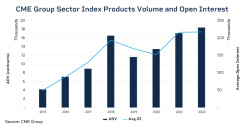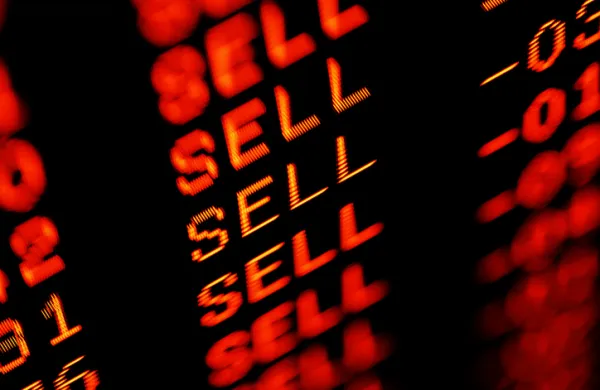Ivan Castano, for CME Group
AT A GLANCE
- Six new contracts offer futures market participants access to tools tracking some of the most popular S&P and Nasdaq sector indices, including semiconductors and biotech
- New derived block functionality allows market participants to “have additional methods of access to liquidity” says Joe Paccione, J.P. Morgan’s head of Americas Futures and Options Sales and Execution
Until now, most of these highly watched sectors were not available to trade as futures contracts.
To bridge this gap, CME Group launched six new E-mini sector index futures in August, giving traders greater flexibility to hedge positions on increasingly popular economic sectors amid historic stock market volatility.
Along with oil and gas exploration and production, and semiconductors and biotech, customers can also trade contracts on indices tracking the performance of regional banks, insurance and retail.
The new offerings “hit home where there is greatest volatility,” according to Anthony Crudele, a futures trader and host of the Futures Radio podcast.
Robust Demand and Early Adoption
Underscoring brisk demand for such products, screens have been strong so far. More than 11,000 contracts changed hands in the first full month of the new sector futures launch, up sharply from the 48 that were initially traded when CME Group introduced sector futures in 2011. In the first half of 2022, sector futures average daily volume is up 10% to over 19,000 contracts while on a three-year basis, it has climbed roughly 50%. The six new products bring CME Group’s total offering to 19 equity sector index contracts.Read more about equity index sector futures
The decision to roll out the new contracts stemmed from robust client interest.
"We continue to see strong market demand for liquid, cost-effective and capital-efficient tools to track the same underlying indices as some of the most popular ETFs," said Tim McCourt, CME Group global head of Equity and FX Products.

Paul Woolman, head of EMEA Equity and Alternative Index Products at CME Group, highlighted semiconductors as an example.
“Semiconductors is an active space and something which we didn’t provide exposure to before, so we started to see client requests for additional sector futures products,” he said.
Market participants have also been seeking greater granularity in the financials space, where the broader “financials” sector offerings may not be specific enough to address their risk management needs. The new regional banks and insurance sector futures help address this need for greater precision, added Woolman.
The new sectors are also eligible for derived block functionality, which provides market participants with greater choice in the way they can seek liquidity by sourcing it from related markets such as ETFs or underlying stock baskets and then transferring it into the sector futures product.
Sector Rotation Drives Alpha
Clients can also obtain relative value, or alpha, by rotating between outperforming and underperforming sectors underlying a broad index, according to Woolman. They can pit sectors against each other, an index or a single stock, and take a directional view if they think, for instance, that a specific segment will perform in a certain way.Jon Corin, vice president of delta one trading at Citi, said the new sector futures fit within “a full universe of financing products that allow us to switch between swaps, futures, cash and ETF funding.
“Now we have the ability to look at relative value between these different instruments and an opportunity to fund our book in more creative ways.”
Derived Block Trades and Capital Efficiency
Derived Blocked trades are also gaining traction with the institution’s customers.“We have had a number of clients checking prices and getting familiar with the tool so there is growing appetite for its use,” said Steve Christian, managing director of execution sales at Citi. “The facility allows clients to access underlying liquidity at any point during the cash session. That is an improvement from the previous, more captive basis trade at index close (BTIC) which was settled at the end of day.”
The last (or Phase 6) of the Uncleared Margin Rules (UMR) regulation raising buy-side firms’ margin costs came into play on September 1, putting 1,100 firms into scope. As firms work to adapt to new initial margin requirements, managing capital efficiency has become increasingly crucial.
The fledgling sectors help in this regard, especially when it comes to trading futures versus ETFs, according to Joe Paccione, head of Americas Futures and Options Sales and Execution at J.P. Morgan.
“With UMR continuing to phase in, capital efficiency is on everyone’s mind,” he said. “As more and more of the OTC products move to listed, it creates additional resources to balance exposure and enhance margin efficiencies.”
Amid this shake up, the ability to execute block trades has become a “turning point” he said.
“The derived blocks create additional access to liquidity throughout the day, allowing traders an alternative method of getting their hedge off, potentially putting that risk into futures,” he said.
“I think that feature brings it on par with other products. Then you add in capital efficiency and the UMR rollout, I can see more and more interest moving to futures.”
Sectors to Watch: Oil, Semiconductors, Biotech
Meanwhile, Crudele expects the increasingly popular oil and gas and semiconductor and biotech sectors to gain the most traction as traders begin using the new contracts.“The oil and energy sectors are the most popular in the S&P 500 this year so there is a lot of liquidity,” he said.
“Semiconductors and biotechs are also high-flying sectors right now,” Crudele added. “With semis, you have a massive amount of volatility coming as you never know what will happen with geopolitical risk, and semis are a key part of our technology world. When you look at Nvidia and AMD, for example, a ton of retail and professional investors are trading these stocks every day.”
The biotech industry also remains susceptible to headline-driven volatility.
“We are in a world where a lot of headline risk is going to come from the biotech side of things because of fear of new COVID-19 variants or a new pandemic and now the Monkeypox outbreak,” added Crudele.
Paccione at J.P. Morgan says the firm’s clients have more options as attention moves from one sector to another.
“It’s not that one is more popular than the other or one is more desirable than another,” he says. “Now that you have this option within the futures construct, it will provide an additional alternative for customers, allowing them to use futures as opposed to just the OTC markets or ETFs.”
Greater Precision
Crudele also sees traders using block trades to more precisely manage risk or express their view on a particular sector or index performance.“The exciting part of the E-mini S&P is that it’s the most widely traded index in the world. From that perspective, we can now trade the strongest versus the weakest sectors and create strategies beyond trading the single index,” he mused.
Before the six new sectors’ launch, “we mostly traded S&P and ESG indices, but these new sectors are really hitting where the volatility is in the current marketplace,” he added.
“If you have a big stock portfolio and you look at the S&P and say, ‘I want to short it but have a heavy weighting in oil and semiconductors,’ you can offset that by going short on the S&P and simultaneously long on oil and semiconductors. In this way, you can more accurately express your view.”
Citi’s Corin expects demand for the E-mini sector futures to grow sharply in the future.
“There are many investors who don’t have the ability to trade cash instruments so this could open up a window for certain market participants to trade sectors they have not had access to historically, generating additional liquidity in the process.”






